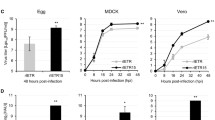Summary
Human-avian and human-mammalian influenza A virus reassortant clones with the neuraminidase (NA) gene of the A/USSR/90/77 (H1N1) strain and hemagglutinin (HA) genes of H3, H4 and H13 subtypes had been shown in an earlier publication to produce low HA yields in the embryonated chicken eggs. The low HA titers had been shown to be due, at least in part, to the formation of virion clusters at 4°C; the clustering was removed by the treatment with bacterial neuraminidase [Rudneva et al., Arch. Virol (1993) 133: 437–450]. By serial passages of the reassortants in chick embryos non-aggregating variants were selected: the variants produced HA titers of the same order as A/USSR/90/77 parent virus. The assessment of the virus yields by the analysis of the partially purified virus preparations from fixed volumes of the allantoic fluid revealed that actual virion yields of the initial reassortants were lower than the yields of their passaged variants or of the parent viruses. The passaged variant of a reassortant possessing the HA gene of A/Duck/Ukraine/1/63 (H3N2) virus differed from the original (non-passaged) reassortant and from the parent A/Duck/Ukraine/1/63 virus in the reaction with a panel of monoclonal antibodies against H3 hemagglutinin. The data suggest that some HA-NA combinations may lead to an incomplete functional match between HA and NA and to the formation of low-yield reassortants, thus representing a possible limiting factor in the emergence of new HA-NA combinations in natural conditions.
Similar content being viewed by others
References
Breuning A, Scholtissek C (1986) A reassortant between influenza A viruses (H7N2) synthesizing an enzymatically inactive neuraminidase which is not incorporated into infectious particles. Virology 150: 65–74
Daniels RS, Douglas AR, Skehel JJ, Wiley DC, Naeve CW, Webster RG, Rogers GN, Paulson JC (1984) Antigenic analyses of influenza virus haemagglutinins with different receptor-binding specificities. Virology 138: 174–177
Guo Y, Xu X, Cox NJ (1992) Human influenza A (H1N2) viruses isolated from China. J Gen Virol 73: 383–388
Kida H, Brown LE, Webster RG (1982) Biological activity of monoclonal antibodies to operationally defined antigenic regions on hemagglutinin molecule of A/Seal/Massachusetts/1/80 (H7N7) influenza virus. Virology 122: 38–47
Kilbourne ED (1987) Influenza. Plenum Press, New York
Rudneva IA, Kovaleva VP, Varich NL, Farashyan VR, Gubareva LV, Yamnikova SS, Popova IA, Presnovs VP, Kaverin NV (1993) Influenza A virus reassortants with surface glycoprotein genes of the avian parent viruses: effects of HA and NA gene combinations on virus aggregation. Arch Virol 133: 437–450
Schulman JL, Palese P (1977) Virulence factors of influenza viruses. WSN virus neuraminidase is required for productive infection of MDBK cells. J Virol 24: 170–176
Spear PG, Roizman B (1972) Proteins specified by herpes simplex virus. Purification and structural proteins of the herpes virion. J Virol 9: 143–159
Warren L (1959) The thiobarbituric acid assay of sialic acid. J Biol Chem 234: 1971–1975
Author information
Authors and Affiliations
Rights and permissions
About this article
Cite this article
Rudneva, I.A., Sklyanskaya, E.I., Barulina, O.S. et al. Phenotypic expression of HA-NA combinations in human-avian influenza A virus reassortants. Archives of Virology 141, 1091–1099 (1996). https://doi.org/10.1007/BF01718612
Received:
Accepted:
Issue Date:
DOI: https://doi.org/10.1007/BF01718612



